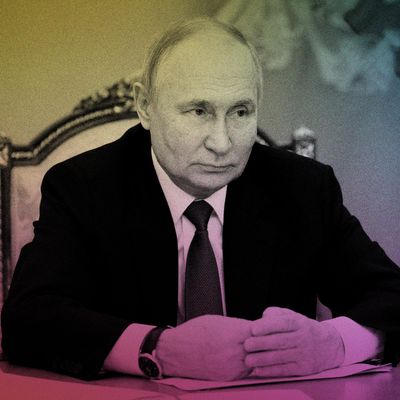
Russia has been bombarding Ukraine from the air for more than 15 months, but recently, the tables have turned. In May, drones buzzed harmlessly near the Kremlin in what Vladimir Putin nonetheless called an assassination attempt. Later in the month, drones targeted residential areas in Moscow, in a remarkable demonstration of impunity. Meanwhile, pro-Ukrainian militants have launched several attacks into Russian territory in the Belgorod region, and Ukrainian shelling in the area has killed multiple people. Some Russians are now living in fear, the way many of their Ukrainian counterparts have been since February 2022. I spoke with Dr. Stephen Hall, an assistant professor in Russian and post-Soviet politics at Bath University, about who is probably behind the drone attacks and the psychological and practical effect that repeated incursions into Russian territory could have on the war.
Recently, Moscow and a few other Russian towns have come under the kind of drone attack that we’ve seen Ukraine suffer throughout this war, especially in Kyiv. U.S. officials have said that Ukrainians were behind at least one of these attacks. Ukraine has denied direct responsibility. First of all, what’s your theory on who’s doing this? Do you buy the U.S. explanation, or do you think it could be Russian nationals fighting against their government, or, more far-fetched, a false-flag operation?
For better or worse, this can only be speculative at the moment. I don’t buy the false-flag thing, and I can explain that in more detail later. So that leaves us with two potential scenarios. One is that it’s Russians either linked to the Russian Freedom Legion or the Russian Corps, or just Russians in general. I find that hard to believe because, just by my understanding of the Russian surveillance system, groups of Russians, even if they’re just a small cell, would come under serious suspicion if they were able to launch that many drones. So my understanding is that it is probably the Ukrainian side, but they’re obviously not going to advertise that. We’ve seen that the drones were flying very low. One scenario says that they came all the way from Ukraine, and by flying low they got past the Russian Air Defense systems. I’m not a military expert, but I believe that is plausible.
However, we are talking about roughly 800 kilometers. And while we know that the Russian Air Defense system or Russian Armed Forces have not been quite as good as we thought they were before February 2022, I still think they would notice and that they would find ways to deal with the situation, such as using anti-drone systems.
Another possible scenario is the idea that the SBU, the Ukrainian Security Services, bought a factory in Moscow oblast, which is like Greater London or New York State compared to New York. We’ve seen with the Crimean Bridge attack — the SBU created lots of shell companies, so it was very hard to track, and they managed to get these companies to buy all the produce or all the stuff they needed and get a person to take the lorry across the Crimean Bridge.
That’s pretty sophisticated.
As I say, it’s a scenario I’ve heard of. Whether it’s true remains to be seen, but I think certainly that the evidence at the moment points toward the Ukrainians. Plausible deniability is important. So this will be something they will never openly admit until after the war.
And you’ve said it doesn’t make sense for a false-flag attack to be as low-grade as this one.
Exactly. If the whole point of the false flag is to mobilize your people, and to get them up in arms against the Ukrainians, then … I don’t want to use the conspiracy theory of the 1999 apartment bombing centered around Moscow, but that’s what we’re talking about. You’d see an apartment block go down. And it probably wouldn’t happen in Rublyovka, which is where the political elite live. You’d find some obscure town like Lyubertsy, or somewhere else in Greater Moscow. So, yeah, I don’t buy the false-flag narrative. Three scrapes to three residential buildings is not going to get the average Russian up off their sofa, into military fatigues, and out to Ukraine.
The U.S. has said that “as a general matter,” it doesn’t support these kinds of strikes within Russia. But it doesn’t really seem to be actively discouraging them, and Western Europe isn’t raising protests either. At some point, do you think the U.S. or West writ large might tell Zelenskyy that he’s playing with fire, that he should stop prodding a nuclear power like this, or does Ukraine’s need to defend itself and win the war supersede those concerns?
There’s always that possibility. But every red line that Putin or Dmitry Medvedev has come up with has been crossed, and Russia hasn’t done anything. And so where is the red line? And it’s clearly in one person’s mind as to where that red line will be.
Ukraine has been more confident about crossing those lines than the West has been — that Russia’s scariest threats are just bluster. So far, they’ve been right. But they might be wrong one day.
They might be wrong one day, but it would be Ukraine that suffers. The Ukrainians know the Russians very well. They’ve had a long history with them, and they know the Russian psyche. And that’s something the West, I think, has learned an awful lot from over the last year.
But Ukraine is at war, Ukraine has been bombed, and it’s probably in their understanding — and this is something I probably agree with — that it’s about time the Russians experienced it. Kyiv has been under fire for the past five days with drones, and numerous times before that. In order to stop the Russian war machine, the war machine has to be stopped in Russia. It’s not as if everything is happening inside Ukraine. Russian factories are churning out weapons. The Russian reserves are in Russia, and the population of Russia also needs to see what’s happening. Whether that will lead to change remains unlikely. But they need to know that it isn’t just happening in Ukraine. It isn’t a war on television like the Iraq war was for Britain in 2003.
If a small group of Ukrainian forces who may or may not be operating under the auspices of the actual government is behind these attacks, it means that a few people can just launch a drone attack on an enemy city fairly easily, with possibly huge repercussions. What does this say about the future of warfare?
The ability to pick up a drone, even just a civilian drone from, let’s say, Alibaba, and militarize it, is something that has never really existed before. You can’t really go and buy a large pickup truck and turn it into a tank, at least not easily. It’s not something the average person is capable of doing. Whereas you can strap a grenade onto a civilian drone and fly it off. So it is relatively easy for a small group of trained civilians, if you want to call them that, or people in the army, to send a wave of drones that won’t be picked up by the current anti-aircraft systems because they’re focused on aircraft.
There is certainly catch-up for governments and states to do. War has always been one of the great events for the building of technology.
Do you have any sense of whether these operations are connected to the Ukrainian counteroffensive we’ve been hearing so much about, and which may or may not have already started? Is this a psychological precursor to the actual military operations?
In terms of the Russian military, yes, it is psychological because you keep them in suspended tension. So they’re constantly thinking — is tomorrow going to be the day? The Economist has been tracking it, and over two weeks in May, there were 907 fires across Russian-held territory in Ukraine. And these fires are almost certainly linked to shelling.
So if you can keep up that level of tension, it’s naturally going to have a psychological effect. And if you keep up that amount of shelling, the enemy is going to know, if not today, tomorrow. If not tomorrow, the day after. It’s a constant state of preparation and waiting, and waiting kills, in terms of the tension. It also brings the war to Russia and shows the weakness of the state. It may not actually lead to a chain of mass protests. It may not lead to the people rising up. It has the potential to actually produce a rally-around-the-flag effect. In 1999, after Russia went into Dagestan in Chechnya, the various bombings that occurred across Russia did highlight that the state was weak, but also prompted the civilian Russians to say, “Well, the state is weak, but we have to support it.”
And, of course, it underlines the original, ludicrous message of the war, which is that Ukraine caused all this.
Yes. So it has the potential to backfire. But I think at the moment, it is the case that the occasional attack on Moscow highlights that the regime is unable to defend its capital city. The analogy of 9/11 is wrong, but the shock of that — of seeing drones attacking buildings in the capital city — is going to have an effect. And also what’s happening with Shebekino, in Belgorod— the simple fact that they’ve been forgotten. The Russian media seems to have washed its hands of the fact that a city on the border with Ukraine is going up in flames. So that also has a psychological effect, at least at the local level — that the regime simply can’t or doesn’t care about defending its people.
This interview has been edited for length and clarity.






























